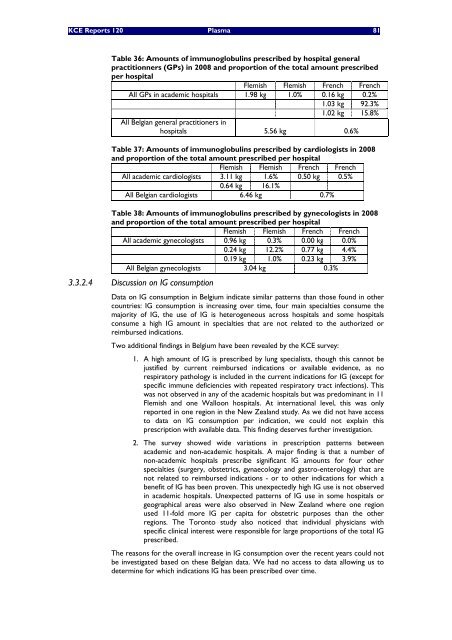The report is available in English with a French summary - KCE
The report is available in English with a French summary - KCE
The report is available in English with a French summary - KCE
Create successful ePaper yourself
Turn your PDF publications into a flip-book with our unique Google optimized e-Paper software.
<strong>KCE</strong> Reports 120 Plasma 81<br />
Table 36: Amounts of immunoglobul<strong>in</strong>s prescribed by hospital general<br />
practitionners (GPs) <strong>in</strong> 2008 and proportion of the total amount prescribed<br />
per hospital<br />
Flem<strong>is</strong>h Flem<strong>is</strong>h <strong>French</strong> <strong>French</strong><br />
All GPs <strong>in</strong> academic hospitals 1.98 kg 1.0% 0.16 kg 0.2%<br />
1.03 kg 92.3%<br />
1.02 kg 15.8%<br />
All Belgian general practitioners <strong>in</strong><br />
hospitals 5.56 kg 0.6%<br />
Table 37: Amounts of immunoglobul<strong>in</strong>s prescribed by cardiolog<strong>is</strong>ts <strong>in</strong> 2008<br />
and proportion of the total amount prescribed per hospital<br />
Flem<strong>is</strong>h Flem<strong>is</strong>h <strong>French</strong> <strong>French</strong><br />
All academic cardiolog<strong>is</strong>ts 3.11 kg 1.6% 0.50 kg 0.5%<br />
0.64 kg 16.1%<br />
All Belgian cardiolog<strong>is</strong>ts 6.46 kg 0.7%<br />
Table 38: Amounts of immunoglobul<strong>in</strong>s prescribed by gynecolog<strong>is</strong>ts <strong>in</strong> 2008<br />
and proportion of the total amount prescribed per hospital<br />
Flem<strong>is</strong>h Flem<strong>is</strong>h <strong>French</strong> <strong>French</strong><br />
All academic gynecolog<strong>is</strong>ts 0.96 kg 0.3% 0.00 kg 0.0%<br />
0.24 kg 12.2% 0.77 kg 4.4%<br />
0.19 kg 1.0% 0.23 kg 3.9%<br />
All Belgian gynecolog<strong>is</strong>ts 3.04 kg 0.3%<br />
3.3.2.4 D<strong>is</strong>cussion on IG consumption<br />
Data on IG consumption <strong>in</strong> Belgium <strong>in</strong>dicate similar patterns than those found <strong>in</strong> other<br />
countries: IG consumption <strong>is</strong> <strong>in</strong>creas<strong>in</strong>g over time, four ma<strong>in</strong> specialties consume the<br />
majority of IG, the use of IG <strong>is</strong> heterogeneous across hospitals and some hospitals<br />
consume a high IG amount <strong>in</strong> specialties that are not related to the authorized or<br />
reimbursed <strong>in</strong>dications.<br />
Two additional f<strong>in</strong>d<strong>in</strong>gs <strong>in</strong> Belgium have been revealed by the <strong>KCE</strong> survey:<br />
1. A high amount of IG <strong>is</strong> prescribed by lung special<strong>is</strong>ts, though th<strong>is</strong> cannot be<br />
justified by current reimbursed <strong>in</strong>dications or <strong>available</strong> evidence, as no<br />
respiratory pathology <strong>is</strong> <strong>in</strong>cluded <strong>in</strong> the current <strong>in</strong>dications for IG (except for<br />
specific immune deficiencies <strong>with</strong> repeated respiratory tract <strong>in</strong>fections). Th<strong>is</strong><br />
was not observed <strong>in</strong> any of the academic hospitals but was predom<strong>in</strong>ant <strong>in</strong> 11<br />
Flem<strong>is</strong>h and one Walloon hospitals. At <strong>in</strong>ternational level, th<strong>is</strong> was only<br />
<strong>report</strong>ed <strong>in</strong> one region <strong>in</strong> the New Zealand study. As we did not have access<br />
to data on IG consumption per <strong>in</strong>dication, we could not expla<strong>in</strong> th<strong>is</strong><br />
prescription <strong>with</strong> <strong>available</strong> data. Th<strong>is</strong> f<strong>in</strong>d<strong>in</strong>g deserves further <strong>in</strong>vestigation.<br />
2. <strong>The</strong> survey showed wide variations <strong>in</strong> prescription patterns between<br />
academic and non-academic hospitals. A major f<strong>in</strong>d<strong>in</strong>g <strong>is</strong> that a number of<br />
non-academic hospitals prescribe significant IG amounts for four other<br />
specialties (surgery, obstetrics, gynaecology and gastro-enterology) that are<br />
not related to reimbursed <strong>in</strong>dications - or to other <strong>in</strong>dications for which a<br />
benefit of IG has been proven. Th<strong>is</strong> unexpectedly high IG use <strong>is</strong> not observed<br />
<strong>in</strong> academic hospitals. Unexpected patterns of IG use <strong>in</strong> some hospitals or<br />
geographical areas were also observed <strong>in</strong> New Zealand where one region<br />
used 11-fold more IG per capita for obstetric purposes than the other<br />
regions. <strong>The</strong> Toronto study also noticed that <strong>in</strong>dividual physicians <strong>with</strong><br />
specific cl<strong>in</strong>ical <strong>in</strong>terest were responsible for large proportions of the total IG<br />
prescribed.<br />
<strong>The</strong> reasons for the overall <strong>in</strong>crease <strong>in</strong> IG consumption over the recent years could not<br />
be <strong>in</strong>vestigated based on these Belgian data. We had no access to data allow<strong>in</strong>g us to<br />
determ<strong>in</strong>e for which <strong>in</strong>dications IG has been prescribed over time.

















